How to make spillways from the roof: general recommendations for arranging a drainage system with your own hands
Until weirs for the roof are installed, the construction of the house cannot be considered complete. They protect the facade, foundation and blind area from the damaging effects of moisture. To create such a system, you can purchase ready-made modules, order an assembly, or build it yourself. In any case, knowledge of the general rules comes in handy.
You will learn all about the specifics of the device of the drainage system from our article. We will talk about how to design and calculate a spillway circuit. We will show you how to choose the material for assembly and install the structure for the removal of atmospheric water.
The content of the article:
Features of the organization of the roof drain
Installing a roof drain is not so difficult. Most manufacturers offer off-the-shelf circuits with detailed installation instructions.
The main task is to preliminarily think out where and where the water will merge, correctly make the wiring and make measurements. When drawing up a drawing, it is necessary to take into account building standards and recommendations that have already been tested in practice.
Varieties of drain structures
First you need to choose the type of system - internal or external, organized or unorganized. The type of spillway depends on the number of storeys of the building, roofing material.
It is advisable to equip houses with over 6 levels with an internal spillway. These are heated buildings with a rolled or mastic roof. An internal drain is also suitable for a flat roof.
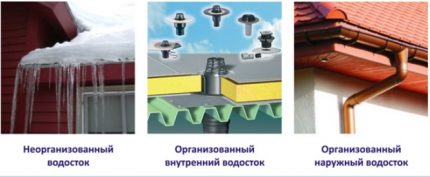
If the levels are up to 2, you can get by with an unorganized system. The most acceptable and recommended by SNiP option for buildings up to 5 levels is an external organized drain. It is easier to install than others and not difficult to maintain.
The main factors in the design
Before buying drainage elements, a drawing of the perimeter of the roof with all the protrusions, turns, and angles are measured. This helps to determine the parameters of the system, to make calculations. But the design of the drain should be based on a rationale.
There are 3 factors that are considered in the calculations:
- The area and design features of the roof.
- Amount of precipitation.
- The lowest possible temperature.
The diameter and footage of the pipes, the number of funnels and brackets - all this depends on the area of the roof. If it does not exceed 100 m2, gutters with a diameter of 7-11.5 cm are suitable, the diameter of drainpipes is 7.5-13 cm. If the roof area is more than 100 m2, gutters with a cross section of up to 20 cm and drains up to 16 cm are needed.
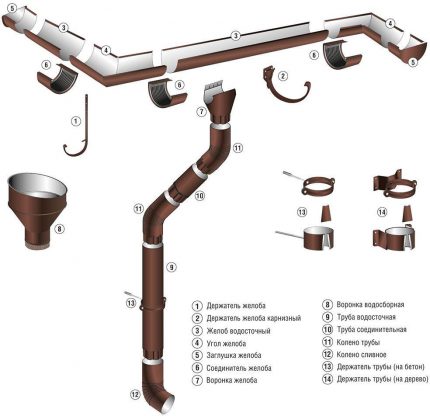
Usually design and gutter type selection does not cause difficulties. The simplest systems are designed for single-pitched and gable roofs. Traditionally, two separate gutters are equipped for gable roofs, for continuous gable roofs, a continuous circuit. In frame buildings, vertical pipes are placed on the supporting racks.
Requirements for the design of the drain:
- the angle of the ramp for installing hanging gutters should be more than 15 degrees;
- gutters are selected with a side height of 12 cm;
- structural elements are checked for compliance with GOST 7623-75, where their technical parameters, marking features are indicated;
- drain points are set up to a distance of 24 m;
- pipe diameter is calculated by the formula - 1.5 cm per 1 m3;
- the slope angle of the gutters is 0.2-0.3 degrees or from 2 to 5 mm per linear meter.
These parameters may vary depending on climatic conditions. The standards provide parameters for the eastern system installed in regions with average temperature (minimum risk of freezing) and precipitation (75 mm / h).
At the design stage, it is necessary to consider a version of the system for collecting and discharging rainwater transported through the drainage system. Ideally, it’s better to dispose of it in storm sewer, but there may be other options: discharge to the collector, followed by discharge into the gutter, filter wellfiltering field, rainwater collection tank etc.
Principle of calculation of parts
The number of gutters is calculated along the perimeter of the roof and the length of one slope. Next, the number of joints of the parts is determined and it turns out how many connecting elements are needed.
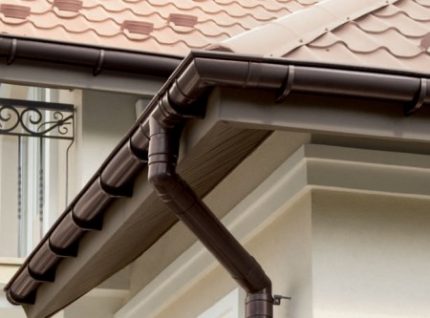
The number of fasteners depends on the material chosen for gutter devices: for metal, the inter-mounting distance is 40 cm, for plastic - 70 cm. Plugs are placed on each pipe break, funnels on each drain.
It is impossible to calculate the exact amount of materials only by the roof area. Two roofs, identical along the perimeter, can have a drain different in parameters and cost.
The nuances of arranging a roof of complex shape
Here you need to collect water from each slope, bay window, it is advisable to mount several gutters. If you equip the system according to the minimum principle, a strong flow will fall into the pipes, which will slow down when passing through the gutters. This will put a strain on the entire structure.
Sometimes additional channels for collecting water are needed over balconies, around the perimeter of turrets, in architectural superstructures. Such places are problematic to get rid of freezing and moisture.
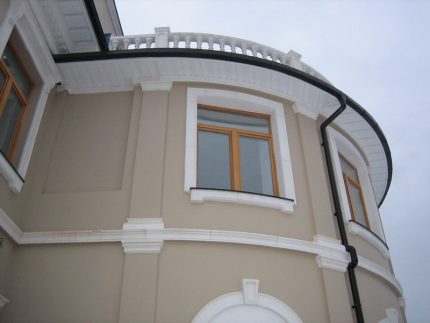
For lucarnes and skylights, drains are optional. They are made only on condition of a large area and multidirectional slopes.
Another possible problem when designing a gutter for a complex roof is a large number of elements. Color helps out: details are matched to the tone of the roof or contrasting with it. The design also uses the shape of the profile when it is installed as an architectural element.
The choice of materials for the drainage system
Quality, appearance, price - these are three parameters that guide the choice of materials for a spillway. Climatic conditions are also important: in regions with a sunny, hot summer, metal is preferable; for areas with high humidity, plastic is better.
Compare plastic and metal products An article on the analysis and evaluation of both varieties will help to organize the drain.
There are several options on the market:
- Galvanized steel. Inexpensive and easy to install solution. But steel is subject to corrosion, so the durability of the structure is doubtful.
- Polymers. They look attractive, you can choose the color to match the roof, serve for a long time. But they are distinguished by moderate fragility, they require accuracy during installation.
- Copper and aluminum. These materials look solid, emphasize the material capabilities of the owner. Their service life is unlimited. The only thing that stops you from buying copper or aluminum parts is the high cost.
Regardless of the material, each system consists of pipes, prefabricated funnels, corners and gutters. The drainage system consists in assembling them according to a pre-made diagram and mounting. Parts are connected using adapters with gaskets.
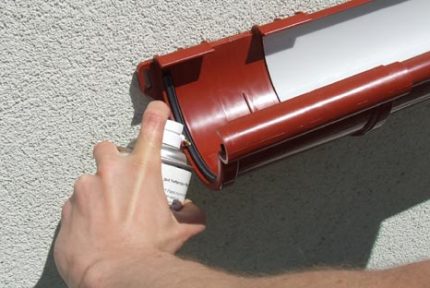
It is important that all the necessary components of the spillway are found in the same outlet and from the same manufacturer. Lack of anything can slow down the installation process.
Choosing the details of the drain, do not experiment with attempts to adapt artisanal elements made to existing circumstances. It is better to immediately dwell on products from trusted manufacturers.
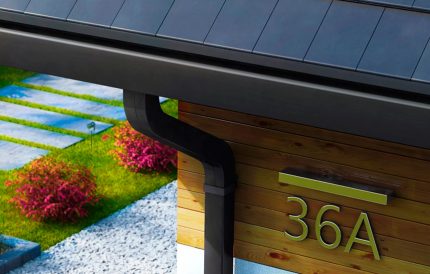
When choosing a material, the reliability of the rafter system is also important, it must withstand the weight of the weir. If in doubt, dwell on lightweight polymer structures.
Features of the installation of elements
Time installation of a drainage system depends on the stage of construction / installation work. During the construction of the building, it is installed before laying the coating. During the repair period, if there was no plan to change the roof, installation is carried out at any time, but the gutter brackets in this case are attached to the windshield, and not to the rafters.
Until recently, there were only subroof fasteners. Today you can find different types of hooks, brackets that allow you to collect drainage before and after installation of the roof.
The general installation algorithm looks like this:
- The location of the vertical pipes is determined taking into account the placement of doors and windows. Usually these are the corners of the building or the center of the facade (if the length of one wall is more than 18-20 m).
- Funnels are installed at the lowest point of the gutter.
- Brackets are mounted. The main holders are placed 10-15 cm from the funnels, the rest - at the same distance of 40-60 cm from each other.
- The gutter is laid in the brackets, taking into account the expansion of the selected material.
- Mounted gutter connectors between the brackets with a distance of 10-15 cm.
- The gutter is connected to the funnels. If the gutter consists of several parts, it is more convenient to assemble them first, and then fix them along a conditional line that continues the roof. The distance is about 1 cm from the edge of the roof.
- Corners and caps are mounted. If the angle at the roof is not straight, adjustable parts are selected that are cut along the lines of rotation. So the bay windows cost.
- Pipes are installed 3-8 cm from the wall of the building. Plastic or metal clamps are fixed, fixing the drain to the facade.
The distance from the final discharge to blind areas- from 15 cm to the ground - from 25 cm. If installed below, there will be a risk of ice formation inside the pipes, which can lead to rupture.
From the wall to the pipes, an indent of at least 3 cm must be observed so that the surface does not damp. To bypass architectural elements or change the direction of flow, it is permissible to use a knee of 135 degrees.
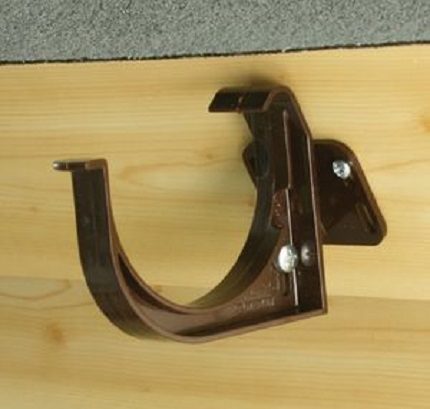
Installation of a plastic drain is carried out at a temperature of +5 degrees and above. Metal system construction it can be made at any time safe for roofers, regardless of temperature indicators. After installation is complete, the system is ready for operation.
Maintenance of prefabricated structures
Modern materials do not need regular staining or processing with special compounds. So that the drainage system copes well with its functions, it must be regularly cleaned of dirt and debris. This is usually done once a year in the fall.
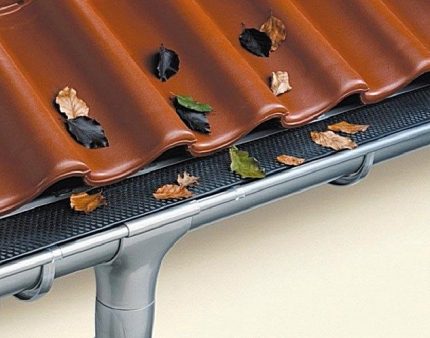
A common method of cleaning is to use a hose when all the dirt is simply washed off by the pressure of water. Robotic devices for plum care are also on sale. They are equipped with an intelligent system that independently calculates when and how many times you need to "drive" through the gutters to remove all garbage.
If you do not monitor the state of the drain, debris can block flows, the liquid will begin to accumulate in problem areas and flow out through the edges of the gutters. Additional load on the pipes will lead to breakage of elements and collapse of the structure.
In order to prevent the formation of ice jams in the gutters and vertical pipes, it is recommended to install gutter heating. The nuances of his choice and the rules of installation will be introduced by our recommended article.
Conclusions and useful video on the topic
Components and installation features of a plastic drain.
What happens to a drain if it is not cleared of dirt in time.
To reliably protect the house from moisture, one drain is not enough. It is necessary to take care of the drainage system, which includes storm trays, gratings on them, sand traps, reservoirs for collecting liquid.
Want to talk about how to build a drainage system with your own hands? Do you have interesting information on the topic of the article, which is worth sharing with site visitors? Please write comments in the block below, post photos, ask questions about controversial or unclear points.

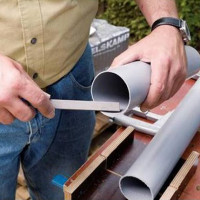 DIY roof gutters: instructions for self-manufacturing a drainage system
DIY roof gutters: instructions for self-manufacturing a drainage system 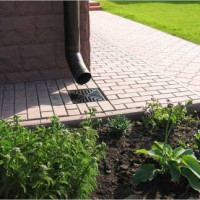 Do-it-yourself storm water drain: all about the installation of a storm shower for a summer house and a private house
Do-it-yourself storm water drain: all about the installation of a storm shower for a summer house and a private house  Which gutter is better - plastic or metal? Comparative review
Which gutter is better - plastic or metal? Comparative review 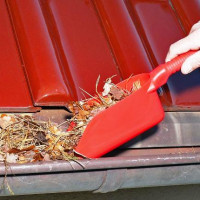 Storm sewer cleaning technology: an overview of popular ways
Storm sewer cleaning technology: an overview of popular ways  Calculation of storm sewers: an analysis of important design features
Calculation of storm sewers: an analysis of important design features  How much does it cost to connect gas to a private house: the price of organizing gas supply
How much does it cost to connect gas to a private house: the price of organizing gas supply  The best washing machines with dryer: model rating and customer tips
The best washing machines with dryer: model rating and customer tips  What is the color temperature of light and the nuances of choosing the temperature of the lamps to suit your needs
What is the color temperature of light and the nuances of choosing the temperature of the lamps to suit your needs  Replacement of a geyser in an apartment: replacement paperwork + basic norms and requirements
Replacement of a geyser in an apartment: replacement paperwork + basic norms and requirements
Not mentioned a very important point. The drainage system must be supplemented by storm sewer. Water from the roof should be completely collected by storm water inlets and discharged by storm channels.Otherwise, ice will form in winter, and the tile (or any other coating) from permanent contact with water will be destroyed much faster. For an example, look at how drainage systems are made in Scandinavian countries: their drainage elbow has a straight shape, as a rule.
I would also add a taboo on the use of used parts, even if they look good. I saw a couple of times how money-hungry homeowners drove someone else's gutter under their walls. I did not even suspect such a phenomenon until I saw it myself. Such a drain will flow in an inaccessible place, and you will only find it when the walls and foundation begin to decay.